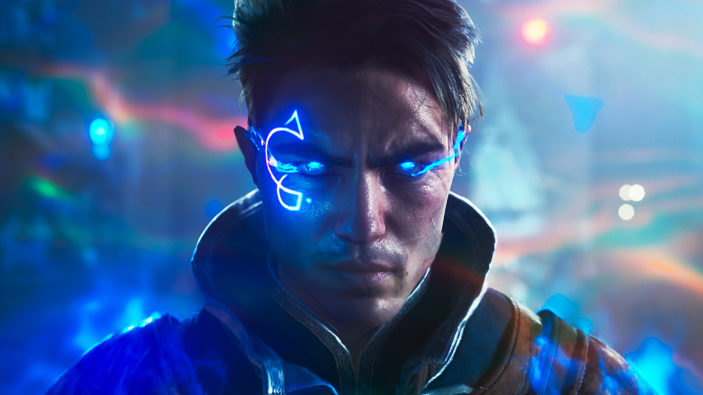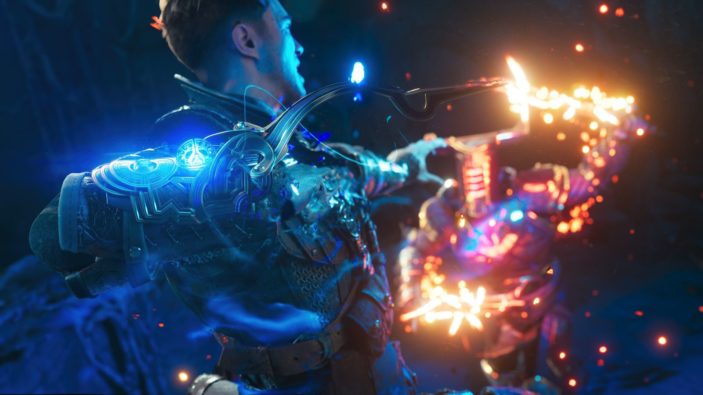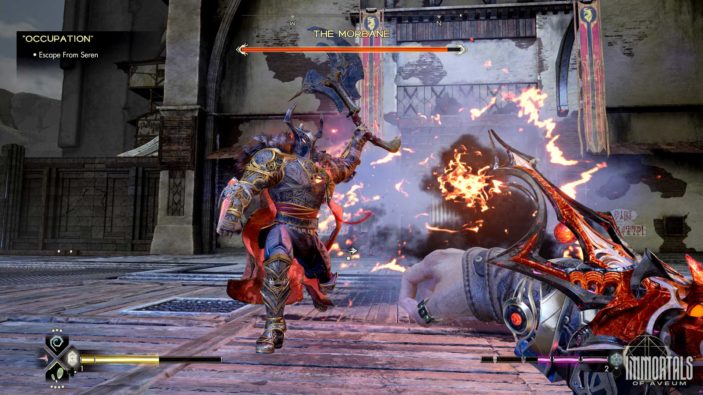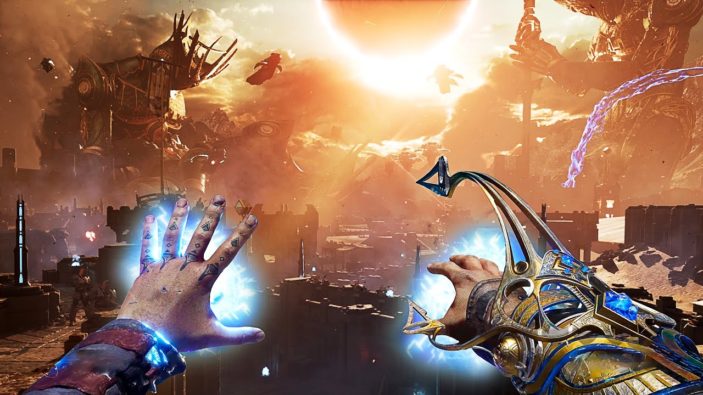
I’m a sucker for magic and fantasy as much as the next guy. Immortals of Aveum comes out swinging, dishing out some gorgeous visuals, clean first-person combat and a story that, while not groundbreaking in terms of lore and emotional depth, does help things churn along at a consistent pace. Its repetitive encounters and linear nature might hold it back from being truly fantastic, but this is ultimately a satisfying ride worth taking.
The War for Aveum
In a world where magic is common, social classes are divided in terms of their magical ability. Players take on the role of Jak, a lowly street urchin who, after a brief introduction mission, finds out that he possesses the power of a Triarch. These rare and powerful people are able to simultaneously use Aveum’s three types of magic at any given time. Cut to a few years later, and Jak finds himself locked in the thick of the Everwar, otherwise known as the ultimate war for total control over Aveum’s magic against the evil tyrant, Sandrakk.

Thankfully, Immortals of Aveum’s story never feels overbearing or slow, presenting a number of twists and turns to keep players interested for the entire 20-hour ride. The general pacing also relies on cutting a lot of fat, meaning most lore is either glanced over or rarely addressed again in the later segments. It’s more focused on getting to the point as opposed to letting its events sit with you for too long. Jak as a protagonist is interesting enough, even if he feels like the mid-2000s hero who finds his charm through cool poses and witty quips.
Pew Pew Magic
You’ll spend most of your time travelling through the many environments, cities and caves of Aveum, all of which look gorgeous. Colours feel vibrant, while both general textures and character models pop. Lighting also looks great, most of which makes that next-gen hardware feel rather necessary. The main attraction here, however, is the combat. Jak’s abilities allow him to wield three types of magic, from the straight-shooting Blue Force magic that focuses on accuracy, to the Red Chaos magic that emits short-range blasts akin to a shotgun and Green Life magic, which sacrifices damage effectiveness for a rapid-fire rate and healing abilities.
The visual flare on display here is truly impressive. Spells burst out of your arms and fly about in different directions, creating a dazzling visual feast for the eyes. It never really gets old either, and while it can look a little chaotic at times to the casual observer, you soon find a rhythm in the bombastic nature of the colours and effects.
Combat feels responsive and punchy, most of which will feel both familiar and accessible to anyone who has ever played a first-person shooter before. You’ll also need to switch between certain magic types based on certain enemies, which keeps each of the magical types and overall combat feeling fresh throughout.

Jak’s non-dominant hand allows him to take advantage of a number of special abilities, including a shield, a whip-like energy beam that can pull enemies in from a distance, and green sludge balls that can be launched at certain enemies to slow them down. Additional Mana abilities can also be used to take out certain enemy abilities like shields for example. Throughout the world, you’ll collect Mana crystals, which can be used to recharge these abilities.
Jak can also find and upgrade new gear along the way, which usually translates to stronger magical abilities and a new look for his sigil, better known as the tool from which he harnesses and shoots magic. Abilities can also be upgraded, but nothing ever feels critical or important enough to acquire at any point, that changes combat in any meaningful way.
The only gripe I have with combat comes from the structure and layout of its encounters more so than the mechanics themselves. While you’ll traverse through many different environments, combat encounters are often confined to an enclosed arena, where you’ll need to clear out a certain number of enemies before moving on. Unfortunately, you’ll be able to pick these spots out quite early into the experience, taking away much of the overall surprise and suspense. There are a number of boss fights that do their best to shake things up, but they feel too few and far between.
Take a Stroll
Combat will take up most of your time, but you’ll occasionally get the chance to solve some environmental puzzles in order to progress. These puzzles generally boil down to shooting nearby glyphs and signs with the matching magic types, which unlock doors. They don’t feel overly difficult, nor do they take up too much of your time, but do a great job at breaking up the pace between the chaotic action and snazzy cutscenes.

The cutscenes themselves make up for most of the cinematic quality here, as the gameplay usually has you solving those puzzles or shooting enemies. Performances are generally well-acted and the motion capture brings an impressive level of detail and accuracy, given Jak bears the likeness of his voice actor Darren Barnet (Gran Turismo, Never Have I Ever).
The soundtrack is also super cool and strangely fitting. While it usually ramps up the epic orchestra during combat, it slips in these synth-based underlying tracks that feel way more natural and impactful than they have any right to be.
Final Thoughts
Overall, Immortals of Aveum excels at creating a unique and functional first-person shooter. It’s not going to break new ground in terms of its overall story and character development, and its combat design and general linear nature hold it back from its true potential. But thanks to its dazzling visuals and solid mechanics balance enough of the moment-to-moment gameplay, it provides a strong foundation for a rather engaging shooter that ticks enough of the boxes to make this worth the 20-hour single-player trip.
THREE AND A HALF STARS (OUT OF FIVE)
Highlights: Strong combat mechanics; Vibrant visuals
Lowlights: Repetitive combat encounters
Developer: Ascendant Studios
Publisher: Electronic Arts
Platforms: PlayStation 5, Xbox Series X/S, Windows PC
Available: Now
Review conducted on PlayStation 5 with a pre-release code provided by the publisher.
